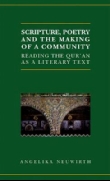Sökning: onr:22280724 > Scripture, poetry, ...
- 1 av 1
- Föregående post
- Nästa post
- Till träfflistan
Scripture, poetry, and the making of a community : reading the Qurʼan as a literary text / by Angelika Neuwirth.
- Neuwirth, Angelika (författare)
- Institute of Ismaili Studies.
- ISBN 9780198701644
- Publicerad: Oxford : Oxford University Press, in association with the Institute of Ismaili Studies, 2014
- Engelska xl, 470 pages
- Serie: Qur'anic studies series
- Bok
Innehållsförteckning
Sammanfattning
Ämnesord
Inställningar
Hjälp
Stäng
- Introduction -- I. Pagan and Monotheistic Frameworks -- 1. Neither of the East nor of the West (lāsharqīyyatan wa-lāgharbīyyatan, Q. 24:35): Locating the Qurʼan within the History of Scholarship -- 2. From Tribal Genealogy to Divine Covenant: Qur'anic Re-figurations of Pagan Arab Ideas Based on Biblical Models -- 3. Glimpses of Paradise in the World and Lost Aspects of the World in the Hereafter: Two Qurʼanic Re-readings of Biblical Psalms -- 4. Images and Metaphors in the Introductory Sections of the Early Meccan Suras II. The Liturgical Qurʼan and the Emergence of the Community -- 5. From Recitation through Liturgy to Canon: Sura Composition and Dissolution During the Development of Islamic Ritual -- 6. Sūrat al-Fātiha: Opening of the Textual Corpus of the Qurʼan or Introit of the Prayer Service? -- 7. Referentiality and Textuality in Sūrat al-Hijr (Q. 15): Observations on the Qur'anic 'Canonical Process' and the Emergence of a Community -- 8. From the Sacred Mosque to the Remote Temple: Sūrat al-Isrāʼ (Q. 17), between Text and Commentary -- 9. A Discovery of Evil in the Qurʼan?: Revisiting Qurʼanic Versions of the Decalogue in the Context of Pagan-Arab Late Antiquity -- III. Narrative Figures between the Bible and the Qurʼan -- 10. Narrative as a Canonical Process: The Story of Moses Seen through the Evolving History of the Qurʼan -- 11. Oral Scriptures in Contact: The Quar'anic Story of the Golden Calf and its Position between Narrative, Cult and Inter-communal Debate -- 12. Imagining Mary, Disputing Jesus: Reading Sūrat Maryam (Q.19) and Related Meccan Texts in the Context of the Qurʼanic Communication Process -- 13. Mary and Jesus: Counterbalancing the Biblical Patriarchs: A Re-reading of Suūrat Maryam (Q. 19) in Sūrat Āl ʻImrān (Q. 3) -- 14. Myths and Legends in the Qurʼan: An Itinerary through its Narrative Landscape.
- We are used to understanding the Qur'an as the "Islamic text" par excellence, an assumption which, when viewed historically, is not evident at all. More than twenty years before it rose to the rank of Islamic Scripture, the Qur'an was an oral proclamation addressed by the Prophet Muhammad to pre-Islamic listeners, for the Muslim community had not yet been formed. We might best describe these listeners as individuals educated in late antique culture, be they Arab pagans familiar with the monotheistic religions of Judaism and Christianity or syncretists of these religions, or learned Jews and Christians whose presence is reflected in the Medinan suras. The interactive communication process between Muhammad and these groups brought about an epistemic turn in Arab Late Antiquity: with the Qur'anic discovery of writing as the ultimate authority, the nascent community attained a new 'textual coherence' where Scripture, with its valorisation of history and memory, was recognised as a guiding concept. It is within this new biblically imprinted world view that central principles and values of the pagan Arab milieu were debated. This process resulted in a twin achievement: the genesis of a new scripture and the emergence of a community. Two great traditions, then, the Biblical, transmitted by both Jews and Christians, and the local Arabic, represented in Ancient Arabic poetry, appear to have established the field of tension from which the Qur'an evolved; it is both Scripture and Poetry which have produced and shaped the new Muslim community. -- provided by publisher.
Ämnesord
- Kristendom och islam (sao)
- Islam och judendom (sao)
- Arabisk litteratur -- historia (sao)
- Auktoritet -- religiösa aspekter (sao)
- Qurʼan as literature. (LCSH)
- Islam. (LCSH)
- Arabic literature -- History and criticism. (LCSH)
- Islam -- Relations -- Christianity. (LCSH)
- Islam -- Relations -- Judaism. (LCSH)
- Arabic literature. (fast)
- Christianity. (fast)
- Interfaith relations. (fast)
- Islam. (fast)
- Judaism. (fast)
- Qurʼan as literature. (fast)
- Islam (gnd)
- Entstehung (gnd)
- Philologie (gnd)
- Authority -- Religious aspects. (fast)
- Islam -- Judaism (LCSH)
- Judaism -- Islam (LCSH)
Genre
- Analys och tolkning (saogf)
- Criticism, interpretation, etc. (fast)
- History. (fast)
Titel
- Qurʼan -- Evidences, authority, etc.
- Qurʼan -- History.
- Qurʼan.
- Koran
- Koranen
Klassifikation
- BP131.8 (LCC)
- 297.1221 (DDC)
- Cmdd.01 (kssb/8 (machine generated))
Titeln finns på 2 bibliotek.
Bibliotek i västra Sverige (1)
Ange som favorit- Göteborgs universitetsbibliotek Humanistiska biblioteket (G)Ange som favorit
- Titeln i bibliotekets lokala katalogFind@GU
-
- Placering: 200 17/479
Bibliotek i södra Sverige (1)
Ange som favorit- Linnéuniversitetet, Universitetsbiblioteket Växjö (LnuV)Ange som favorit
- Titeln i bibliotekets lokala katalog
-
- Placering: 297 Neuwirth
- 1 av 1
- Föregående post
- Nästa post
- Till träfflistan
Sök vidare
Hjälp
- Fler titlar av
- Neuwirth, Angelika
- Institute of Ismaili ...
- Fler titlar om
-
- Qurʼan
- Qurʼan
- och Evidences authority ...
- Qurʼan.
- Koran
- Koranen
- Kristendom och islam
- visa fler...
- Islam och judendom
- Qurʼan as literature ...
- Islam.
- visa färre...
- Fler titlar i denna genre
- Analys och tolkning
- Criticism, interpret ...
- History.
- Serie
- Fler delar
Sök utanför LIBRIS
Hjälp
- Sök vidare i:
- Google Book Search
- Google Scholar
- LibraryThing
Kungliga biblioteket hanterar dina personuppgifter i enlighet med EU:s dataskyddsförordning (2018), GDPR. Läs mer om hur det funkar här.
Så här hanterar KB dina uppgifter vid användning av denna tjänst.
Copyright © LIBRIS - Nationella bibliotekssystem

